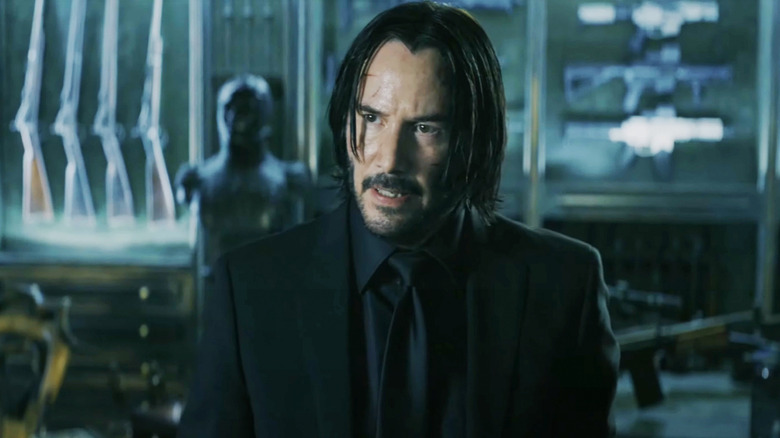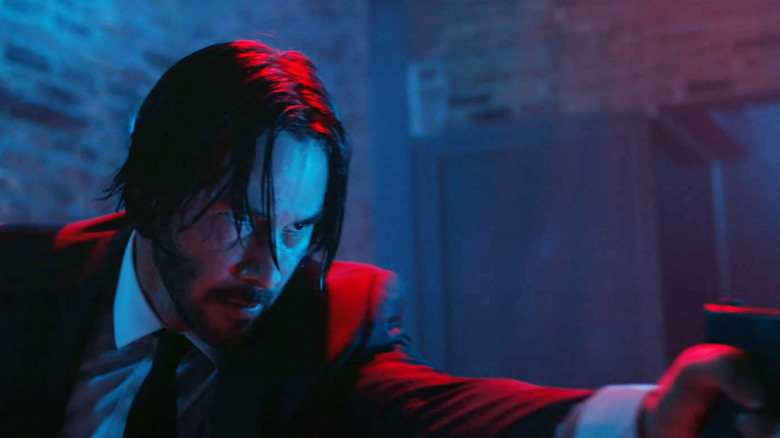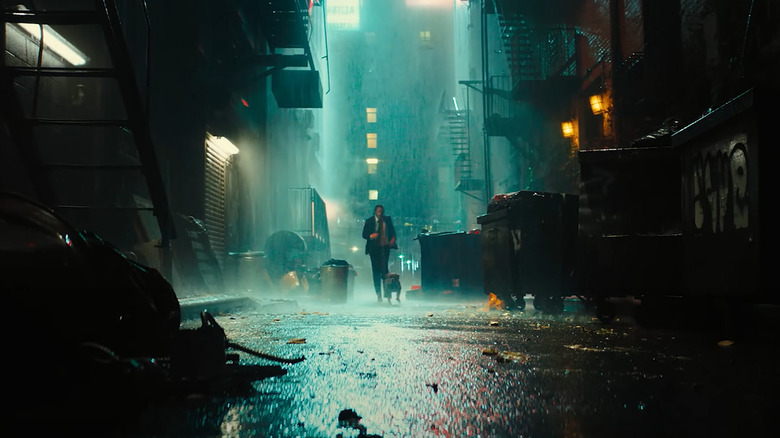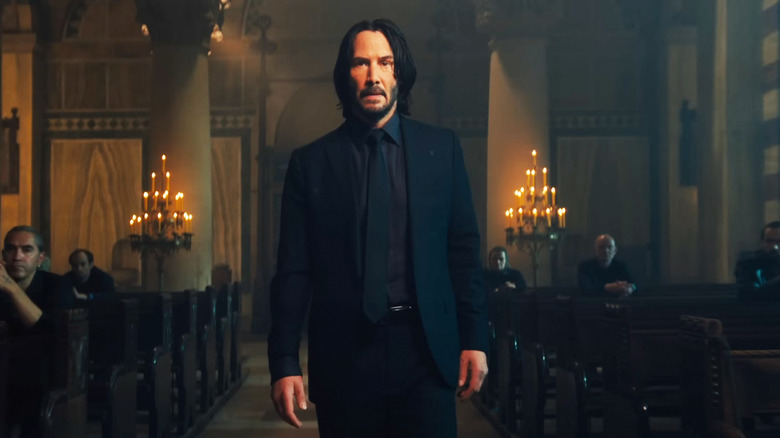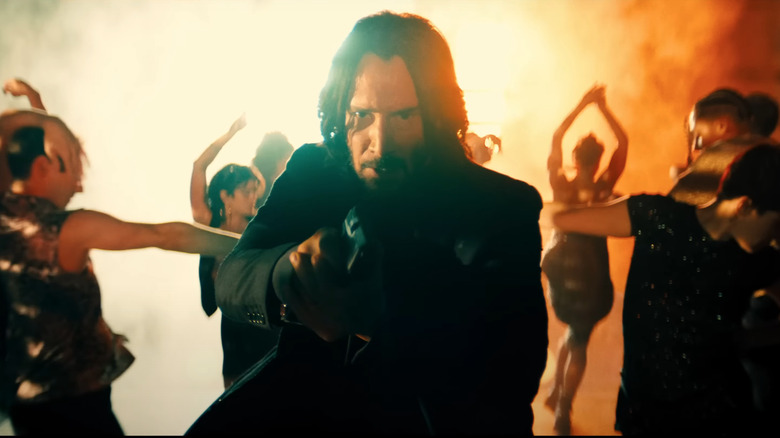Keanu Reeves Thinks A Key To John Wick's Success Is Not Insulting The Audience
John Wick will soon return in "John Wick: Chapter 4," and at this point, he's basically become a synonym for near-invincible badass. Back in the 1980s, there were action icons like Rambo, who came to represent a similarly invincible figure in the public consciousness, capable of dispatching whole armies single-handedly. But in the 2010s, the pop culture landscape lacked such a figure. Matt Damon's Jason Bourne was the closest thing we had in the 2000s, but his action thrillers, coming as they did in the age of the "gritty reboot," seemed more grounded, despite their protagonist's improbably elite combat skills.
By 2014, however, audiences were ready for a break from the bleak aesthetic of the 2000s, which had seen everyone from James Bond to Batman brought down to Earth via their own more naturalistic reboots. And Keanu Reeves was the man to give it to them. After the massive hit that was 1999's "The Matrix," Reeves stayed in the spotlight for some time, before eventually seeing his career decline, culminating in the unmitigated disaster that was "47 Ronin" in 2013.
But the following year, he would start to turn it all around by starring as the titular hitman in "John Wick." At the time, Variety reported the film "looked like a dud" prior to its release and seemed likely to be "another nail in [Reeves'] career coffin." On the contrary, the action thriller's fastidiously-choreographed gun-fu style combat, overseen by directors and stunt choreographers Chad Stahelski and David Leitch, proved popular with audiences and critics. The film brought in $14 million in its first weekend — double what it was projected to make — and the franchise that grew out of this first movie eventually became as unstoppable as the central assassin himself. And Reeves has some thoughts as to why.
The rise of John Wick
"John Wick" eventually earned a respectable $86 million at the global box office, but it was the fact it had overperformed so significantly against expectations that hinted at big things to come. Word of mouth and a growing cult following led to increasing popularity for both Keanu Reeves as an actor and his peerless assassin character, prompting Lionsgate to greenlight a sequel. "John Wick: Chapter 2" arrived in 2017, doubling down on the action and expanding the John Wick lore significantly. Its unabashed embrace of action over a story and character development made the second installment even more successful than the first, with the sequel making more than double the box office of "John Wick," raking in $171 million in global receipts.
By the time "John Wick: Chapter 3 — Parabellum" debuted in 2019 and made $328 million during its theatrical run, not only had Reeves hit the height of his newly rekindled public adoration, the John Wick franchise's action movie majesty had rewritten the rules of the genre. From "Atomic Blonde" to "Nobody" — both made with the involvement of "John Wick" alum — action movies basically became attempts to emulate the unique combat of the Reeves-led series.
At this point, the John Wick character has become the preeminent badass, transcending his movies to become a cultural touchstone. Anyone who's paid the slightest bit of attention to pop culture of late knows what it means to "go John Wick." And media companies have taken notice, putting the character in everything from video games to comic books. He was even given the "Simpsons" parody treatment in 2021, firmly cementing John Wick's status as a pop culture mainstay.
'It's the blend of elements'
So, how did the "John Wick" franchise, which started life as a film most thought would tank, become so successful? Keanu Reeves has a few thoughts. In a chat with Collider in March 2019, when the actor was asked about the series' success, Reeves said:
"I would say it's the blend of elements that it has. I think the way the action is and the world that's created. I think the cinema of the series is really strong — you know, the framing, the camera movement. I think the set design is really great. So, I think the film is really easy to watch. It's beautiful. There's a character that we root for, hopefully. He's fighting for his life. They're not insulting. The films are fun, but they're smart. There's humor, and action. Comedy. It has a unique tone, I think. So, you can tell I'm a fan. So, I would say those are the elements."
One important element Reeves misses here is himself. He's often accused of being a somewhat wooden actor, and you can draw your own conclusions on that. But, much like James Stewart in "Rear Window" and "Vertigo," the man can do nothing really well, which as /Film's Senior News Editor Jacob Hall observed back in 2017, is a great thing when used properly: "It's all about teaming Reeves with a storyteller who understands that this is a leading man who works best as a cog in a larger machine."
Of course, it also helps that he's insanely dedicated to doing his own stunts and that Chad Stahelski designed the signature "John Wick" gun-fu style to showcase the fact that it is the actor himself performing the action. But as Reeves points out in his comments, he's ultimately one part of a larger whole.
The legend of Baba Yaga
Far be it from me to contradict Baba Yaga, but I gotta say, I disagree somewhat with Keanu Reeves. Not that the set design doesn't help, or that we're not rooting for Wick to finally defeat the High Table and earn his freedom. But I think the keys to the "John Wick" series' success are the fight choreography and, most crucially, the return to an action movie sensibility that, prior to 2014's inaugural Wick outing, had been consigned to Hollywood history.
To briefly return to "Rambo," when Sylvester Stallone saw the initial cut of 1982's "First Blood," he was convinced the movie would ruin his career. According to Stallone, that three-hour cut contained too much of his own dialogue, which he stripped from the film in order to, as he told Howard Stern, "have other people talk about [Rambo]." In the final cut of the movie, Rambo's former commanding officer, Colonel Samuel R. Trautman (Richard Crenna) tells Sheriff William Teasle (Brian Dennehy), "I didn't come here to rescue Rambo from you, I came here to rescue you from him." He also launches into a monologue about how the former Green Beret is "the best, with guns, with knives, with his bare hands. A man who's been trained to ignore pain, ignore weather, to live off the land, to eat things that would make a billy goat puke."
This approach of allowing other people to talk up the protagonist's skills proved to be a stroke of genius, as it established Rambo as an almost mythological figure within the context of the film — a status he came close to occupying in popular culture over the course of four sequels. And as it happens, this is basically what the "John Wick" films have done with their central character.
The key to success
From the very first movie, John Wick's legend as an unstoppable killing machine feared by even hardened crime bosses is established by everyone but himself. In much the same way as "First Blood" allows others to talk up the central character, it's Russian mob boss Viggo Tarasov (Michael Nyqvist) who says that Wick is "the one you send to kill the f***ing boogeyman" and that he once saw Wick "kill three men in a bar with a pencil." (Keanu Reeves pushed to make that pencil bar fight happen.)
This technique, which Sylvester Stallone referred to as like a "Greek Chorus," became synonymous with cheesy action movie clichés once the 1990s arrived and blockbuster stars such as Sly and Arnold Schwarzenegger starred in movies that basically parodied their former roles. Films such as "Kindergarten Cop," or worse, the film Arnie tricked Sly into starring in, "Stop! Or My Mom Will Shoot," represented the beginning of the end for the '80s action star.
What "John Wick" did — at the right time — was it made many '80s action clichés cool again. No longer was grandiose language about someone being "the best of the best" relegated to Steven Seagal's direct-to-DVD movies. When Variety reported that "'John Wick' looked like a dud," going into its opening weekend, it was precisely because the film appeared to be Reeves stooping to Seagal levels of action cliché.
But thanks to the wholly original combat design and modern visual style, "John Wick" managed to sneak not just this "Greek Chorus" technique back into the mainstream, but a whole action movie style focused on high-octane combat and gratuitous violence. Even if people hadn't realized they'd missed it, they did once "John Wick" debuted. And that, I believe, is the real key to the series' success.
